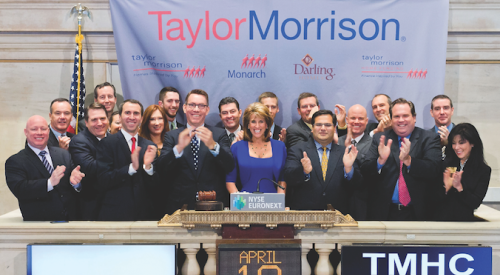|
|
|
|
|
|
|
Who's No.1 in housing revenue matters to the public homebuilders at the top of PB's rankings, mostly because it's a measure of their own choosing. But the powerful stock analysts who shape Wall Street's perception of the builders as investment vehicles favor a different metric return on invested capital.
The builders all say that size brings economies of scale, such as better land buys and lower prices for labor and materials. They say that geographic diversity protects them from local and regional economic downturns that plague smaller, single-market builders. They say big is beautiful, and so they compete to see who is the biggest of all.
"I'm not interested in who's No. 1," veteran analyst Barbara Allen of Natexis Bleichroeder says. "I'm a lot more interested in profitability per house and how well-prepared the builders are to protect earnings in a downturn. We've had No.1 homebuilders go bankrupt several times in past recessions. When you hear these guys talk about how big they're going to get, they are all assuming that interest rates will remain at 40-year lows and current loose underwriting standards for mortgages will remain in place."
Another veteran analyst, Tim Jones of Wasserman & Associates, puts it this way: "Do I care if a builder is No. 1 or No. 3? How much is there to choose between the No. 1 and No. 3 in the advantages that bigness brings? Enron was No. 1 in oil futures, and look where it got them. Levitt's was No. 1 in furniture, and they went under. It doesn't mean you're great."
What does? The analysts now place much greater stock in a metric called "return on invested capital." Credit Suisse/First Boston analyst Ivy Zelman explains: "You take operating profit before interest expense and taxes, which is operating income, then you tax-affect everybody as if they are all the same. That gives you after-tax operating income. Then you divide by average debt and average equity, not including interest.
"That shows you what the company is delivering on its base of capital as a return to shareholders," Zelman says. "It doesn't necessarily align with earnings per share. This is a better, apples-to-apples metric."
Return on invested capital has become the ultimate Wall Street scorecard, Zelman says. "It's not about one aspect of the P&L or one aspect of the balance sheet. This encompasses it all."
Some builders like return on invested capital better than others. "Toll hates it," Zelman says, "because they own a lot of land an eight-year supply, assuming current closings. They've got a lot of capital just sitting there in land. If you take their operating income divided by average debt and average equity, they're not getting a return on that land yet.
"NVR only options land. They own none. That's why they have the best ROIC and also why they're trading at a screaming premium to the group." (NVR at press time was trading at a price-to-earnings ration of 8.0 compared with the 5.9 average for the group Zelman tracks.)
|












